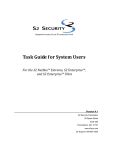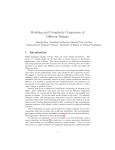Download Networking and Security Research Center
Transcript
Networking and Security Research Center Technical Report NAS-TR-0162-2012 SABOT: Specification-based Payload Generation for Programmable Logic Controllers Stephen McLaughlin and Patrick McDaniel 21 July 2012 The Pennsylvania State University 344 IST Building University Park, PA 16802 USA http://nsrc.cse.psu.edu c 2012 by the authors. All rights reserved. SABOT: Specification-based Payload Generation for Programmable Logic Controllers Stephen McLaughlin Patrick McDaniel Systems and Internet Infrastructure Laboratory Pennsylvania State Univesity Systems and Internet Infrastructure Laboratory Pennsylvania State Univesity [email protected] [email protected] ABSTRACT sary cannot construct a payload for specific devices without knowing how the PLC interfaces with those devices. However, there is often no way of determining which PLC memory locations regulate which devices. This paper presents S ABOT (Specification-based Attacks on Boolean Operations and Timers)1 , a proof-of-concept attack tool for generating PLC payloads based on an adversary-provided specification of device behavior in the target control system. S ABOT’s main purpose is to recover semantics of PLC memory locations that are mapped to physical devices. Specifically, S ABOT determines which memory locations map to the devices in a behavioral specification of the target plant. This enables an adversary with a goal to attack specific devices to automatically instantiate that attack for a specific PLC in the victim control system. Unlike previous attacks, such as Stuxnet [18], a precompiled payload is not necessary. An attack using S ABOT proceeds as follows: Programmable Logic Controllers (PLCs) drive the behavior of industrial control systems according to uploaded programs. It is now known that PLCs are vulnerable to the uploading of malicious code that can have severe physical consequences. What is not understood is whether an adversary with no knowledge of the PLC’s interface to the control system can execute a damaging, targeted, or stealthy attack against a control system using the PLC. In this paper, we present S ABOT, a tool that automatically maps the control instructions in a PLC to an adversary-provided specification of the target control system’s behavior. This mapping recovers sufficient semantics of the PLC’s internal layout to instantiate arbitrary malicious controller code. This lowers the prerequisite knowledge needed to tailor an attack to a control system. S ABOT uses an incremental model checking algorithm to map a few plant devices at a time, until a mapping is found for all adversary-specified devices. At this point, a malicious payload can be compiled and uploaded to the PLC. Our evaluation shows that S ABOT correctly compiles payloads for all tested control systems when the adversary correctly specifies full system behavior, and for 4 out of 5 systems in most cases where there where unspecified features. Furthermore, S ABOT completed all analyses in under 2 minutes. 1. 1. The adversary encodes his understanding of the plant’s behavior into a specification. The specification contains a declaration of plant devices and a list of temporal logic properties defining their behavior. 2. S ABOT downloads the existing control logic bytecode from the victim PLC, and decompiles it into a logical model. S ABOT then uses model checking to find a mapping between the specified devices and variables within the control logic. INTRODUCTION Process control systems are vulnerable to software-based exploits with physical consequences [18, 41, 33, 44, 43, 55, 46, 4, 28, 40]. The increased network connectivity and standardization of Supervisory Control and Data Acquisition (SCADA) have raised concerns of attacks on control system-managed infrastructure [7, 24, 8, 53]. Modern control systems use Programmable Logic Controllers (PLCs) to drive physical machinery according to software control logic. For ease of modification, control logic is uploaded to the PLC from the local network, the Internet, or serial port [49, 13]. For example, hundreds of Internet accessible PLCs and SCADA devices can be found through the Shodan search engine [1, 14]. An adversary with PLC access can upload malicious control logic, called the payload, thereby gaining full control of the devices under the PLC. Nevertheless, an additional challenge still remains: Even with knowledge of the target control system’s behavior, an adver- 3. S ABOT uses the mapping to instantiate a generic malicious payload into one that can be run on the victim PLC. The generic payload can contain arbitrary manipulation of the specified devices, which S ABOT substitutes with PLC addresses. S ABOT is not for adversaries that do not understand the behavior of the victim plant. In such cases, an adversary can erase the PLCs memory, upload random instructions, or attempt to bypass safety properties of the control logic [35]. None of these attacks, however, are guaranteed to be effective or stealthy. Instead, S ABOT is most useful to adversaries with accurate knowledge of the target plant and process, but that are unaware of a critical piece of information: how to manipulate specific plant devices from the PLC. This information is not obvious to the adversary because it is unknown which PLC variables are mapped to plant devices. There are several implications stemming from the existence of a tool like S ABOT: 1. Reduced adversary requirements. In most cases, the only way to know which PLC memory addresses map to which devices is to physically inspect the labels on wires connecting the PLC to devices. Only the most powerful adversaries e.g., insiders or nation Permission to make digital or hard copies of all or part of this work for personal or classroom use is granted without fee provided that copies are not made or distributed for profit or commercial advantage and that copies bear this notice and the full citation on the first page. To copy otherwise, to republish, to post on servers or to redistribute to lists, requires prior specific permission and/or a fee. Copyright 200X ACM X-XXXXX-XX-X/XX/XX ...$10.00. 1 Sabots were wooden shoes thrown into the gears of machinery by Luddites in the Industrial Revolution. 1 states, will have this information [54]. Furthermore, S ABOT enables attacks by adversaries that are unfamiliar with PLC instruction set architectures and communication protocols. Because the variable mapping is done on an intermediate representation, code from arbitrary PLCs can be decompiled for analysis by S ABOT. We give an example implementation of one such decompiler in Section 3.2. 2. Improved target identification. In the Stuxnet attack, PLC version strings and device metadata were used to verify that the correct target had been identified [18]. If this metadata was not found in the PLC, then it was silently ignored by the virus. Using S ABOT, a target is identified by whether or not its control logic behaves in the way specified by the adversary. Thus, the adversary need not know any version strings or vendor metadata a priori. This may also reduce false positives in cases where an unintended PLC contains the expected version strings and metadata. We evaluate S ABOT’s ability to correctly identify a target control logic out of a number of candidates in Section 4.4. 3. Room for error. Using a precompiled payload, an adversary’s understanding of the plant’s behavior must be exactly correct or the payload will likely fail. Using a dynamically generated payload, there is some room for error. For example in Section 4.5 we describe a method for writing behavioral specifications that will correctly map to a control logic regardless of whether or not it implements an emergency stop button, a common feature in many control systems. While this is a first step towards making a truly adaptable attack mechanism, our results show that it works well when an adversary correctly specifies the behavior of a majority of plant devices, as shown in Section 4.1. It is also, to the best of our knowledge, the first analysis of its kind directed at PLC-based control systems. Our evaluations of S ABOT show that it performs accurately and efficiently against control logics of equal or greater complexity than the target of the Stuxnet attack [18]. We begin our discussion of S ABOT in the next section by providing a brief overview of sequential control systems and detail an illustrative example. sensors are used to detect when the tank is at three levels–low, half full, and full (corresponding to inputs x1 , x2 , and x3 , respectively). A level switch xi = > if the contents of the tank are at or above its level. A start signal is sent to the PLC via x4 . The mixer follows a simple process in which ingredient A is added until the tank is half full, ingredient B is mixed with A until the tank is full, and the result is drained. The specification, shown in Figure 1(b), details the control system implementation: 1. Initially, all inputs and outputs are off until the Start button is pressed (x4 = >). 2. At this point the process enters state Fill A (y1 = >), and the tank is filled with ingredient A until the tank is filled midway (x2 = >), at which point the valve for A is closed (y1 = ⊥). 3. Next, the system transitions to the state Mix B, in which ingredient B is added (valve B is opened) until x3 = >. The mixer y3 is also started in this state. 4. At this point, the system closes the value for B and enters the Drain state (y4 = >) until the tank is empty (detected by the “low” sensor x1 = ⊥). At this point, the mixer is stopped. The mixing process is an example of a common class of control systems, called sequential control systems. Sequential control systems drive a physical plant through a process consisting of a sequence of discrete steps. Sequential control is used in industrial manufacturing (automotive assembly, QA testing), building automation (elevators, lighting), chemical processing (process control), energy delivery (power management), and transportation automation (railway switching, traffic lights), among others. Not shown in the example, a timer is a special control system primitive that introduces a preset time delay between when an input becomes true, and when a subsequent output becomes true. A timer only sets the specified output to > when the input has been set to > for the duration of its preset delay value. Timers can be used to replace other sensors. For example, the level sensors above could be replaced with timers, presuming the flow and drain rates of the apparatus were known and fixed. 2. CONTROL SYSTEMS Control systems are used to monitor and control physical processes. These systems can drive processes as simple as motion activated light switches or as complex as wastewater treatment. Regardless of their purpose and complexity, control systems are generally structured the same. The physical apparatus in which the control system resides is called the plant. Within the plant, control systems can be decomposed into three distinct elements: control inputs, control outputs, and control logic. Control inputs are used to communicate the state of the plant. For example, temperature, motion, or light sensors are used to detect and communicate physical states. Other inputs are human driven, such as switches, dials, and buttons. The control system sends output signals to external devices to effect changes in the physical world. For example, such signals may turn on indicator lights, open and close valves, or drive bi-directional motors. The control logic is the PLC software that computes new outputs based on sensor inputs. The PLC repeatedly executes the control logic in a scan cycle consisting of: i. read new inputs, ii. execute control logic, and iii. write outputs to devices. An example control system for a simplified chemical mixer is shown in Figure 1. The plant (Figure 1(a)) is a single mixer with valves to dispense two ingredients, A and B, a mixing element, and a valve for draining the tank. The valves are controlled by the output variables y1 and y2 respectively, the mixer by y3 , and the drain by y4 . A device is ON when its corresponding output variable is set to > (true) and OFF when it is ⊥ (false). Three level 2.1 PLC Logic and ISA The control logic for a sequential process is codified into a set of Boolean circuits that are evaluated in order with dependencies. The circuits are then compiled into the PLC’s native instruction set. The control logic implementation of the chemical mixing process is shown in Figure 1(c). The PLC executes each of the four statements starting with Fill A and ending with Drain once each scan cycle. At the plant start up state, y1 = ⊥. After the button x4 is pressed, y1 = > until x2 = >. Notice that the clause (x4 ∨y1 ) is necessary as x4 is a button that may only be depressed temporarily, thus once y1 is activated, it should remain so until the terminating condition x2 = >. Here, the value of y1 on the right hand side of the statement is the value for y1 from the previous scan cycle. The control output for valve B (y2 ) is activated immediately when y1 = ⊥ on the condition x2 = >. y2 then remains ON until the draining process begins with y4 . The mixer (y3 ) is on as long as the level in the tank has reached midway, and has not subsequently been emptied. Finally, the drain (y4 ) is activated when the tank is full, and remains ON until the tank is empty. A logic program must be compiled to a PLC’s native instruction set architecture (ISA) before being uploaded to the PLC. While ISAs vary between PLC vendors, many are equivalent to the IEC 61131-3 standard for the Instruction List (IL) programming language [25]. We implement an IL decompiler in Section 3.2. 2 Plant A B y1 Process Control Logic (High Level) x4 y2 x3 Start {x1x2 x3x4}= X x2 ... Fill A : Low Level Switch x2 : Mid Level Switch x3 : High Level Switch x4 : Start Button Fill A : y1 Add B : y2 PLC x1 y3 {y1y2 y3 y4} = Y y4 x1 X ∪ Y = VM Mix B Drain y1 : Ingredient A Valve y2 : Ingredient B Valve y3 : Mixer y4 : Drain Valve Mix : y3 Drain : y4 ← (x4 ∨ y1 ) ∧ ¬x2 ← x2 ∧ ¬y4 ← (x2 ∨ y3 ) ∧ x1 ← (x3 ∨ y4 ) ∧ x1 Product (a) (b) (c) Figure 1: An example plant and process specification for a chemical mixing control process. 2.2 Attacking PLCs Decompilation Control systems have shown to be vulnerable to attacks through sensors [36], human machine interfaces [2], and PLCs [18, 6, 40]. In this work we focus on the last of these due to the complete control offered to an adversary by PLCs, and the vulnerability of PLCs relative to the other two. For example, hundreds of Internet addressable PLCs can be found on the Shodan computer search engine [1, 14], and new web-enabled, PLCs are being released into the market place with the aims of making remote management more convenient [49, 13]. An even more common arrangement is to have the control system network connected to a corporate network for economic reasons [53, 43]. Given this requirement, it is indeed the case that all but the most critical PLCs will be at least reachable from public networks. In this work, we consider an adversary that has sufficient knowledge about the behavior of the target control system to design a targeted and perhaps stealthy payload for that control system. While this may sound like a strong requirement, it is important to note that there are several methods through which one can obtain such information. Many control systems, including railway switching, and electrical substations exhibit some or all of their machinery and behavior in plain view. Furthermore, details about plant structure can be gleaned from vulnerable human machine interfaces [3, 2], and scanning of industrial network protocols [35]. Vendors also release device data sheets and sample control logic, precisely defining device behavior, for example [27]. Of course such information is available to low ranking insiders [30]. Finally, we mention that while it is unlikely that unskilled or “script kiddie” adversaries will mount attacks targeted at specific devices, there is existing work describing such naive attacks and their limitations [35]. 3. PLC Code Model Process Specification VTDM Recovery VTDM Payload Construction Generic Malcode Payload PLC Malcode Figure 2: S ABOT: Generating a malicious payload for a target control system based on process specification, the PLC code, and generic malcode. 3.1 Problem Formulation Consider a scenario in which an adversary may wish to cause ingredient A to be omitted from the chemical mixing process described above. A PLC payload for this might look like: Valve A ← ⊥ Valve B ← (Start Button ∨ Valve B) ∧ ¬Drain Valve Intuitively, this control system never dispenses A, but rather fills the tank with B. Unfortunately, the adversary does not know how to specify to the PLC which device is meant by “Valve A” or “Start Button.” This is because PLCs do not necessarily label their I/O devices with semantically meaningful names like “Drain Valve.”2 Instead, PLCs use memory addresses, e.g., x1 , y2 , to read values from and write values to sensors and physical devices. We refer to this set of address names as VM . The adversary, who does not know the semantics of the names in VM , prefers to use the set of semantically meaningful names Vφ = { Start Button, Valve B, . . .}. This raises the problem, How can an adversary project attack SABOT S ABOT instantiates malicious payloads for targeted control systems. Depicted in Figure 2, the S ABOT initially extracts a logical model of the process from the PLC code (see Section 3.2, Decompilation). Next, the model and process specification are used to create a mapping of physical devices to input and output variables (called the variable-to-device mapping, or VTDM, (see Section 3.3, VTDM Recovery). Last, a generic attack is projected onto to the existing model and VTDM to create a malicious payload called the PLC Malcode (see Section 3.4, Payload Construction). This malcode is delivered to the victim interface. 2 Some PLCs such as the Rockwell Controllogix line allow programmers to give names to I/O ports, but these names are still of no use autonomous malware. 3 Desc. Bytecode Accumulator α > And x1 A x1 x1 Nested Or O( > And x2 A x2 x2 And y1 A y1 x2 ∧ y1 Pop stack ) x1 ∨ (x2 ∧ y1 ) Store α to y2 = y2 > C ← C ∪ {y2 ← x1 ∨ (x2 ∧ y1 )} VM ← VM ∪ {x1 , x2 , y1 , y2 } Stack x1 : ∨ x1 : ∨ x1 : ∨ - translated to M using the modeling language of the NuSMV model checker [11]. For step 1, the constraints are obtained via symbolic execution of the bytecode. This requires a preprocessing to remove nonstandard instructions not handled by our symbolic execution. The resulting code conforms to the IEC 61131-3 standard for PLC instruction lists [25]. The control flow graph (CFG) of the resulting code is constructed and a symbolic execution is done over the CFG according to a topological ordering. Several register values are tracked, most importantly the logic accumulator α. An example symbolic accumulation of control logic is shown in Table 1. Step 2 translates the set of constraints resulting from step 1 into a control logic model M that can be evaluated by the NuSMV model checker. NuSMV takes definitions of labeled transitions systems with states consisting of state variables. S ABOT uses the VAR · : boolean expression to declare a state variable for each name in VM . Each Boolean variable is first initialized using the init( · ) expression, and updated at each state transition using the next( · ) expression. A Boolean variable may be initialized or updated to a constant value of > or ⊥, another expression, or a nondeterministic assignment {>, ⊥}, where both transitions are considered when checking a property. For a complete specification of the NuSMV input language, see [9]. As shown in Table 2, there are three translation rules. In the case of input variables, a new Boolean variable is declared, initialized to ⊥, and updated nondeterministically. The nondeterministic update is necessary because all possible combinations of sensor readings must be factored into the model. Output and local variables are initialized to ⊥ and updated according to the expression α. Timer variables require an extra bit of state. Recall that a PLC timer t = > only when its input expression α = > continuously for at least t’s preset time duration. Furthermore, any input variable in the model may change state while the timer is expiring. Thus, for each timer, α must hold for two state transitions. The first transition simulates the starting of the timer’s countdown, and the second simulates the expiration, allowing the timer to output >. An additional step is required for the preprocessing of bytecode. Originally, some Siemens bytecode contains the “and before or” instruction, signified by the mnemonic O. The O instruction breaks up a conjunction into a disjunction of conjunctions. For example, consider the following program: Table 1: Example accumulation of a constraint. payloads using names in Vφ onto a system that uses the unknown memory references VM ? One of S ABOT’s main tasks is to find a mapping from the names in Vφ to those in VM . Here, S ABOT requires one additional piece of information from the adversary: a specification of the target behavior. If the adversary is to write a payload such as the one above for the mixing plant, then it is assumed that he knows some facts about the plant. For example, the adversary can make statements like: “The plant contains two ingredient valves, and one drain valve,” and “When the start button is pressed, the valve for ingredient A opens.” The adversary encodes such statements into a behavioral specification of the target plant. When S ABOT is then given a specification and control logic from a plant PLC, it will try to locate the device addresses that behave the same under the rules of the logic as the semantically meaningful names in the adversary’s specification. Like the payload, the sensors and devices specified in the specification are defined using semantically meaningful names from Vφ . Given a control logic implementation, S ABOT will construct a model M from the control logic (Var(M) = VM ), and perform a model checking analysis to find the Variable To Device Mapping (VTDM) µ : Vφ → VM . S ABOT assumes it has the correct mapping µ when all properties in the specification hold under the control logic after their names have been mapped according to µ. For example, the above property, “When the start button is pressed, the valve for ingredient A opens,” will be checked as, “Under the rules of the control logic, When x4 is pressed, then y1 opens,” under the mapping µ = {Start Button 7→ x4 , Valve A 7→ y1 }. The specification is written as one or more temporal logic formulas φ (Var(φ) ⊆ Vφ ) with some additional hints for S ABOT. For a given mapping µ, the adversary supplied payload or specification under µ, denoted µ/payload or µ/φ, is identical to the original, except with any names from Vφ replaced by names from VM . Thus, to check whether a given mapping µ maps Vφ to the devices is correct, S ABOT checks: A A O A A = M |= µ/φ x3 x4 y1 This is equivalent to y1 ← (x1 ∧ x2) ∨ (x3 ∧ x4). This can be rewritten as: Read, “The temporal logic formula φ with literal names mapped by µ holds over the labeled transition system M.” If these checks are satisfied under a given µ, then S ABOTinstantiates the payload over Vφ into a payload over VM . 3.2 x1 x2 O( A x1 A x2 ) Decompilation O( A x3 A x4 ) To obtain a process model M, S ABOT must first bridge the gap between the bytecode-level control logic, and the model itself. This means decompiling a list of assembly mnemonics that execute on an accumulator-based architecture into a labeled transition system defined over state variables. S ABOT performs this decompilation in two steps. (1) The disassembled control logic bytecode is converted to an intermediate set of constraints C on local, output, and timer variables from the PLC. (2) The constraints in C are then = y1 3.3 4 VTDM Recovery Constraint input x output or local y c=y←α timer t c=t←α NuSMV Model M VAR x : boolean; ASSIGN init(x) := ⊥; next(x) := {>, ⊥}; VAR y : boolean; ASSIGN init(y) := ⊥; next(y) := α; VAR t : boolean, tp : boolean; ASSIGN init(t) := ⊥; next(t) := α ∧ (tp ∨ t) ? > : ⊥; init(tp ) := ⊥; next(tp ) := α; before moving to the next. If no satisfying mapping is found for a given specification, the previous specification’s mapping is discarded, and it is searched again for another satisfying mapping. If no more satisfying mappings are found for the first specification in the specification, the algorithm terminates without identifying a mapping. If a satisfying mapping is found for all specifications, the algorithm accepts this as the correct mapping µSAT Algorithm 1 shows the basic mapping procedure (except for the UNIQUE feature). Algorithm 1: IncMapping Input : µ, spec, VM , M Output: The satisfying mapping µSAT or none 1 if spec = ∅ then 2 µSAT ← µ 3 return > Table 2: Constructing M from constraints C. 4 φ ←Pop(spec) 5 foreach µ0 :Var(φ) → VM do 6 if M |= µ0 /φ then 7 if IncMapping(µ ∪ µ0 , spec, VM − µ0 (Var(φ)), M) Recall that the process specification is the adversary-supplied description and expected behaviors of some plant devices. S ABOT attempts to find a Variable To Device Mapping (VTDM) µ from names in the specification to names in the control logic model M. If the correct mapping is found, then the semantics are known for each name in VM mapped to by µ. A specification is an ordered list of specifications. A specification with name id has the following syntax: 8 then return > 9 return ⊥ We use the NuSMV model checker [11] for deciding M |= µ/φ. The running time of IncMapping is dependent on the number of false positive mappings for each specification in the specification bounded below by Ω(|specif ication|) and above by O(|VM ||Vφ | ). id : <input [input-list]> <output [output-list]> <INIT [init-input-list]> <UNIQUE> φ As an example, we can now restate our earlier specification for the plant start button, “When the start button is pressed, the valve for ingredient A opens,” as the following specification sbutton: 3.3.2 sbutton : input start∗ output vA INIT start∗ start∗ ⇒ AX vA Unambiguous Specifications Consider the problem of writing a specification for the chemical mixer process shown in Figure 1. First, one must define the names in Vφ . Denoting input variable names with an ‘∗ ’, let l1∗ , l2∗ , and l3∗ be the names of the low, mid, and high level switches respectively, and let start∗ be the start button. Additionally, let vA and vB be the valves for ingredients A and B, mixer be the mixer, and vd be the drainage valve. As in the figure, VM = {x1 , x2 , x3 , x4 } ∪ {y1 , y2 , y3 , y4 }. Recall the specification sbutton from above. While sbutton is an accurate specification of plant behavior, it is also ambiguous. To see this, we first consider the case of the correct (true positive) mapping µT P = {start∗ 7→ x4 , vA 7→ y1 }. When the mapping is applied to the CTL specification, we get: µT P /sbutton = INIT x4 x4 ⇒ AX y1 . µT P is the correct mapping because, (1) µT P /sbutton holds under the control logic (Figure 1(c)), and (2) x4 , and y1 are the names of the control input and output for the devices that the adversary intended. Consider an example false positive mapping: µF P = {start∗ 7→ x2 , vA 7→ y2 }. Judging by the same criteria as above, we can see that (1) µF P /sbutton holds under the control logic, but criterion (2) fails because x2 and y2 (the mid level switch and the B ingredient valve respectively) are not the names of control variables intended by the adversary. This raises the question: how can the adversary remove this ambiguity from the specification without a priori knowledge of the semantics of x1 , x2 , y1 , and y2 ? While the adversary does not know the semantics of names in VM , he does know the semantics of names in Vφ . Thus, the adversary need not know that x2 is a name for a mid level switch and not a start button, only that there is some control variable name that corresponds to a mid level switch. But the adversary already has an abstraction for this, the name l2∗ . The same goes for y2 and its abstraction, the name vB . Thus, the adversary can reliably remove The only mandatory part of a specification is the property φ, which is defined in Computational Tree Logic (CTL) [23]. (Interpretations are given in quotes for the unfamiliar reader.) The CTL specification is defined over names given after the input and output keywords, where {input-list} ∪ {output-list} ⊆ Vφ . The S ABOT checker will check this φ under the control logic model M in three steps: 1. Choose µ : {input-list} ∪ {output-list} → VM. 2. Apply µ to φ by substituting all names in φ with their mappings in µ. This is denoted by µ/φ, read “The property φ under the mapping µ.” 3. Check M |= µ/φ. These three steps are applied over all possible mappings for a given specification. There are two more optional parts to each specification, the list of inputs that will be initially ON INIT, and the conflict resolution hint UNIQUE. Any names in init-input-list will have their initial values set to > when checking M |= µ/φ, while all other inputs will have initial value ⊥. This is useful for checking plant starting states. The keyword UNIQUE declares that the names in input-list and output-list will not appear in any conflict mappings. For a definition and discussion of conflict mappings, see Section 3.3.2. 3.3.1 Mapping Specifications to Models S ABOT searches for a mapping µ : Vφ → VM such that M |= µ/φ for every specification φ in the specification. This is done incrementally, finding a satisfying mapping for each specification 5 vA vB mixer vd cf lict : input l2∗ output vB INIT l2∗ l2∗ ⇒ AX vB Because the correct mapping for cf lict differs from the correct mapping for sbutton, we have that l2∗ conflicts with start∗ , and vB conflicts with vA . If the adversary can remove this conflict, then the false positive mapping µF P will also be removed, and the ambiguity is resolved. The conflict can be removed by the addition of the following specification (Read, “Valve A can be on with the start button released”). System Container Filling Motor Control Traffic Signaling pH Neutralization Railway Switching sbindep : input start∗ output vA EF(¬start∗ ∧ vA ) y1 y2 y3 y4 ←⊥ ← (x4 ∨ y2 ) ∧ ¬x3 ← (x2 ∨ y3 ) ∧ x1 ← (x3 ∨ y4 ) ∧ x1 Table 3: Control system variants (omitted shaded). To see that the pair sbutton, sbindep removes the conflict, we can substitute the conflict into sbindp, giving: EF(¬l2∗ ∧ vB ), which does not hold under the control logic. Thus, if the conflicting mapping is initially made when checking sbutton, this mapping will fail when checking sbindep, which will cause the S ABOT checker to go back to sbutton, and search for another mapping, in this case, the correct one. Of course, this approach is not guaranteed to make a completely unambiguous specification (as will be seen in Section 4), but it does remove all ambiguities with respect to devices the adversary is aware of. In larger examples, we keep track of conflicts and resolutions using conflict tables. An example set of conflict tables for a specification of a chemical process is shown in Figure 3. Each specification has a (potentially empty) conflict table listing all unmapped names in Vφ that satisfy the specification. Given a nonempty conflict table for a specification spec, one can make spec unambiguous by writing at most one additional specification over the names in spec for each entry in its conflict table. This guarantees a finite specification size bounded in O(|Vφ |2 ) specifications. Significantly fewer are usually necessary in practice. The specification keyword UNIQUE is used to declare that no name appearing in the specification will appear in a conflicting mapping. This is useful because there are some cases where the same name appears in many conflict table entries. (See specification sbutton in Figure 3). It is never required to use UNIQUE to remove conflicts, but it can be useful in reducing the search space. 3.4 ←⊥ ← (start∗ ∨ vB ) ∧ ¬l3∗ ← (l2∗ ∨ mixer) ∧ l1∗ ← (l3∗ ∨ vd ) ∧ l1∗ Instantiated Payload Ba se Em line e A rgen nn c u y Se nc qu iat o Pa ent r ra ial lle l Generic Payload this ambiguity by checking which names in Vφ are in conflict with names in the property sbutton. For example, consider a specification that has the same structure as sbutton but with different names (Read, “Switch 2 activates valve B”): can cause side effects that may reduce stealthiness or reduce the impact of the attack. E.g., suppressing ingredient A in the chemical mixing process could result in a conspicuous failure later in the process. The impact of side effects may be partially mitigated by the use of low profile attacks such as merely reducing the amount of ingredient A. 4. EVALUATION This section details a validation study of S ABOT focusing on four metrics: • Accuracy is the ability of S ABOT to correctly map a specification onto a control system, even when unexpected features are present. We evaluate the number of devices that are correctly mapped in each test case in Section 4.1. • Adaptability is the ability to recognize different variants of a control system. A canonical specification is tested against two unique implementations of a traffic light control logic, and results evaluated in Section 4.2. • Performance is the ability to efficiently recover the VTDM for a given specification. We evaluate not only the total running time, but the number of false positives encountered by the incremental mapping process in Section 4.3. Payload Construction • Scalability is the ability to perform accurately and efficiently as additional control system functionality is added to the PLC. We augment S ABOT with a basic dependency graph analysis, and evaluate both accuracy and performance for PLCs running multiple independent subsystems Section 4.4. Note that this is the first set of experiments on S ABOT, and additional future studies providing further validation and enlightenment are appropriate. However, the results of this initial study indicate that S ABOT works well on a variety of control logics, and that there remain numerous avenues for engineering and fine tuning results. We evaluate the use of two such improvements to refine our initial results in section 4.5. All experiments are conducted using the five variants of five representative process control systems taken from real-world applications described in Table 3. Each process description is used to implement a specification and a control logic. All specifications were created independently of the implementations. Note that control variables are denoted using emphasis and input variable are annotated with ‘∗ ’ (e.g., invar∗ , outvar) below. While seemingly simple, most of the following systems have a larger variety of devices In the payload construction step, S ABOT instantiates a generic malicious payload for the target PLC. Given a VTDM µ for a victim PLC and specification, S ABOT uses µ to map the names in the adversary’s generic payload into those in the control logic. Thereafter, the instantiated payload is recompiled into bytecode and uploaded to the PLC. S ABOT payloads are control logic programs defined over names in Vφ . Once the VTDM µ is found, the payload is instantiated under µ, producing a payload over names in VM . Using this approach, an adversary can assume the same semantics for names in the payload that are assumed for names in the specification. As an example, the following payload manipulates the chemical mixing process into omitting ingredient A from the mixture. Assuming that the correct mapping, i.e. µT P is found by S ABOT, then this payload will execute as expected when uploaded to the mixer PLC. Our results in Section 4.1 show that the correct mapping can be recovered the majority of the time, even when the plant has unexpected devices and functionality. In the event that S ABOT finds a correct VTDM, but the adversary was unaware of some devices in the plant, an instantiated payload 6 sbutton : INIT start∗ UNIQUE Neutralizer: 1. sbutton 2. latched 3. heateron 4. mixeron 5. mixerindep 6. levelindep 7. level2 8. valve2 1. 2. 3. 4. 5. 6. 7. 11. tlight 12. pHlight ⇒ AX AG(¬ 1. 2. 3. 4. ts ls∗2 ls∗3 as∗ ⇒ AX¬ heater v1 v2 v2 ⇒ AX ¬ mixer v3 v4 tl as ls∗1 ∧ ls∗2 ⇒ AX v2 ) Empty valve4 : AG(ls∗1 ∧ ls∗2 ∧ ls∗3 ⇒ AX v4 ) Empty EF(¬ts∗ ∧ ¬mixer ∧ AX(¬ts∗ ∧ mixer)) Empty valve3 : AG(¬as∗ ∨ ¬ts∗ ∧ ¬v3 ⇒ AX ¬v3 ) Empty levelindep refines mixeron : heateron : UNIQUE AG( 1. 2. 2. ls∗1 ls∗1 ls∗2 ls∗2 ls∗2 mixerindep refines mixeron : Empty ∗ valve2 : INIT ls∗1 , ls∗2 mixeron : v1 v2 mixer heater v4 heater tl al latched refines sbutton : EF(start∗ ∧ AX(¬start∗ ∧ v1∗ )) 9. valve4 10. valve3 start∗ ls∗2 ls∗2 ls∗2 ls∗3 ls∗3 ts∗ as∗ ) EF(ls∗1 ∧ v1 ∧ AX(ls∗1 ∧ v1 )) Empty tlight : AG(¬ts∗ ⇒ AX ¬tl) level2 : AG(¬mixer ∧ ls∗1 ∧ ls∗2 ⇒ AX mixer) pHlight : AG(¬as∗ ⇒ AX ¬al) Empty Empty Empty Figure 3: An unambiguous specification with conflict tables for the pH neutralization system. and more complex state machines than the target of the Stuxnet attack, many uniform variable speed drives [18]. The five applications are: tl al From Source Neutralizer v1 v2 Container Filling. Consider the filling of product containers on an assembly line, e.g., cereal boxes [15]. In the basic process, a belt ls∗3 heater belt carries an empty container (belt = >) until it is under the fillls∗2 ts∗ bin as indicated by a condition cond∗ , e.g., a light barrier detects ∗ when container is in position. Thereafter, a fill valve f ill is opened as ls∗1 for a period of time to fill, and the belt is activated to move the mixer next container into place. It may also occur that the fill bin itself is depleted, as indicated by a level sensor low∗ and a secondary start∗ v4 v3 source bin with valve source will be used to replenished the fill bin. To Source To Next Step Motor Control. Stepper motors provide accurate positioning by dividing a full rotation into a large number of discrete angular poWhen the tank level is below ls∗2 , valve v1 is opened to fill the tank sitions. This has many applications in precision machining equipwith the acidic substance up to level ls∗2 . At this point valve v2 is ment like lathes and surface grinders, and conveyor belts. Most opened to dispense the neutralizer until the correct acidity level is stepper motors also offer bidirectional operation. A motor conindicated by the acidity sensor as∗ = > and the correct tempertroller for a stepper motor will allow for starting the motor in the ature of the product has been reached as indicated by temperature forward direction f on, reversing the motor ron, such that ¬f on ∨ sensor ts∗ = >. If ts∗ = ⊥, the heater is activated. If the desired ¬ron always holds. Buttons are used for selecting forward (f or∗ ) pH level is not achieved before the tank fills to ls∗3 , v2 is closed and and reverse (rev ∗ ) operation, and stopping the motor stop∗ . Larger v4 is opened to drain the tank back to level ls∗2 . Once the correct pH motors that require spin down times before changing direction are level and temperature are achieved, and there is at least ls∗2 liquid in equipped with timers that do not allow for the motor to be started in the tank, it is drained to the next stage by v3 . The temperature and its opposite direction until it has been stopped for several seconds. acidity lights tl and al are activated when the desired temperature 3 Traffic Signaling. Consider further a typical 4-way traffic light and acidity have been reached respectively, and the tank is at least with red1 , yellow1 , and green1 in the North/South direction, and at level ls∗2 . red2 , yellow2 , and green2 in the East/West direction. Ignoring Railway Switching. Lastly, consider a process that safely coordiinputs from pedestrians or road sensors, the traffic light follows the nates track switches and signal lights on a real railway segment [19]: circular timed sequence: (red1 , red2 ), (red1 , green2 ), (red1 , yellow2 ), (red1 , red2 ), (green1 , red2 ), (yellow1 , red2 ). b a pH Neutralization. A pH neutralization system mixes a substance of unknown acidity with a neutralizer until the desired pH level is achieved, e.g., in wastewater treatment. An example process adapted from [17] operates as follows: ← → tr1 s2 ... s1 tr2 ← → c 3 d a∗ b∗ c∗ d∗ s∗1 s∗2 The segment consists of the two tracks (tr1 and tr2 ), two switches (s1 and s2 ) and four signal lights a–d. A switch is said to be in the Traffic signal attacks can cause significant congestion [20]. 7 4.1 normal state if it does not allow a train to switch tracks and in the reverse state if it does allow a train to switch tracks. If a signal is ON, it indicates that the train may proceed and if it is OFF, the train must stop. The direction of each signal is indicated by an arrow. The signalman can control the state of the lights and switches using the inputs s∗1 , s∗2 and a∗ –d∗ , where s∗1 = > puts switch s1 into reverse, and a∗ turns signal a ON. To ensure safe operation, the control logic maintains several invariants over the signal and switching commands from the signalman. (1) Two signals on the same track, e.g., a and b, can never be ON simultaneously. (2) If a switch is in reverse, then at most one signal is allowed to be ON. (3.a) If switch s1 is in reverse, then signals a and c must be OFF. (3.b)If switch s2 is in reverse, then signals b and d must be OFF. (4) If both switches are set to reverse, then all signals must be OFF. Accuracy Recall that accuracy is a measure of the correctness of the identified mappings between internal devices and the process specifications, i.e., the accuracy of the VTDM. Here we measure correctly mapped devices, incorrect mappings (false positives), and failures to identify any mapping at all (false negatives). The results for accuracy experiments are shown in Table 4. To summarize, in three out of five test systems the baseline specification is sufficient to produce a complete, correct mapping for the control system, and four out of five systems had no false positives. As expected, the emergency shutdown case caused false negatives in two out of the three control systems. This was due to the failure of specifications of the form AG(input∗ ⇒ output) to always hold under any mapping when there is always a state in which estop∗ makes the property not hold. The false negatives occur for all devices in both cases, because later specifications contained names that failed to map in earlier specifications, making them uncheckable. The pH neutralization system experienced the most false positives due to its multiple parallel behaviors. In the annunciator panel, the behavior of the valve for the neutralizer (v2 ) could not be distinguished from the annunciator light for the mid level switch ls∗2 because ls∗2 = > implies that both the valve and annunciator light are ON. More broadly, the sequential system false positives were caused by devices in the first instance that were mistaken for a device in the second instance. For example, the heater in the first instance of the pH neutralization system was confused with the heater in the second. The false positives in the parallel case were caused by devices in the first instance that were mistaken for nonequivalent devices in the second. For example, the finished product valve (v3 ) in the first instance of the pH neutralization system was confused with the mixer in the second instance. We improve upon these results in Section 4.5. Each of the applications is implemented in a Baseline control system. Each baseline system is then modified with four variants to introduce plant features not anticipated by the baseline specifications: Emergency. This case adds an emergency shutdown button named estop∗ to each plant. If the emergency shutdown button is pushed, all devices will be immediately turned OFF. One can see how this can cause false negative mappings. For example, a property of the form AG(input∗ ⇒ AX output) will no longer hold, because of the case where input∗ ∧ estop∗ holds, but output is forced to ⊥. The motor controller’s stop button acts as a shutdown, so there was no need to add one. Annunciator. Annunciator panels are visual or sometimes audible displays present within the plant itself. For safety reasons, they are wired directly to the PLC, and used to indicate if there is a condition in the plant that should require special precautions by humans on the plant floor. We place a single annunciator light on each input and output in the plant. This light is turned ON by the control logic if the corresponding input or output is ON, and OFF otherwise. We evaluate the plants with annunciator panels because the annunciator variables nearly double the number of control variables that are expected by the adversary. The traffic signal and railway switching processes were not evaluated with annunciator panels, as annunciator functionality is already present in both systems. 4.2 Adaptability Adaptability is the ability to recognize a control system by its behavior, independent of its implementation. Because S ABOT only considers control logic behavior and not its structure, any implementation conforming to the process description will be handled equivalently. To confirm this is the case, and as an experimental control, a team member not involved in prior analysis was tasked with implementing an alternative traffic signal control program that exhibited the behavior from the description. The team member took an alternative strategy of allowing the light timers to drive the rest of the process, resulting in a significantly different implementation. The same experiments run above were rerun on this new implementation, and the results were identical. Sequential. This case considers a plant with two distinct instances of the process, where the second instance is dependent on the first. For the motor controller, this simply means that the second motor mimics the forward and reverse behavior of the second. The same is true for the traffic lights, where the state of the second mimics the first. For sequential container filling, containers are partially by the first system, then by the second. The railway switching example is modified to include three tracks, and allow a train to switch from the first track, to a middle second track, and then to the third track. The safety properties are extended to prevent any conflicting routes between the three tracks. Finally, the chemical neutralization process is serialized to two tanks, such that the first process fully drains to the second before the second starts. 4.3 Performance To gauge runtime costs, we measured the running time and number of calls to the NuSMV model checker of each experiment conducted in Section 4.1. Note that S ABOT’s running time for a given model and specification is hard to calculate for a given set of inputs because it is highly dependent on the number of incremental mappings attempted. Shown in Table 5, over 75% of tests, the mapping is found in less than 10 seconds, and in 90% of tests, the mapping is found in less than 30 seconds. Two tests however deserve particular attention. The test with a running time of 1m43.6s for parallel traffic signaling made the most calls to the model checker of any test. It also represented the greatest increase in calls to the model checker over its own baseline. This can be attributed to the fact that the traffic signal was the only specification containing specifications that Parallel. This case models two independent instances of the process executing in parallel on the same PLC. This is expected to occur in production environments where it is more cost effective to add more input and output wires to the same PLC than to maintain distinct PLCs for each parallel instance of the process. A special criterion is added for the parallel case called Synchronized, which is true if all mappings where true positives in the same instance of the process. I.e., there is no mixing of mappings between the two independent processes. 8 nt Sta ainer rt F Be Butt illing lt on Fil lV Sy alve nch Mo roni ze to Fo r Co d rw ntr Re ard B ol ver ut Sto se B ton u p tt Mo Butto on n tor Mo For wa to Sy r Rev rd nch er Tr roni se affi zed Re c Sig dL na Re ight l dL 1 Gr ight een 2 Gr Lig een ht 1 L Ye llo ight wL 2 Ye llo ight wL 1 Sy nch ight ron 2 ize d Co pH Control Logic Baseline Emergency Annunciator Sequential Parallel n n n n n n N Sta eutr ali rt z So Butt atio n urc on Ne e Va lve utr To alize rV So Pr urce alve od Va u He ct V lve alv ate e Mi r xer Te mp Ac Sen s or idi Lo ty Se w L ns Mi eve or d L l Sw Hi evel itch gh Sw Sy Leve itch nch lS Ra roni witch ilw zed Sig ay S wi na Sig l A tchin g na Sig l B na Sig l C na Sw l D itc Sw h 1 i tc Sy h 2 nch ron iz e d Control Logic Baseline Emergency Annunciator Sequential Parallel n n n n n n n n n n n n p p p p p p p p p p p p p Table 4: Per-device accuracy results. Empty cell: Correct mapping, ‘p’: false positive mapping, ‘n’:false negative (no mapping), Shaded cell: experiment omitted (see description). System Container Filling Motor Control Traffic Signal pH Neutralization Railway Switching Baseline 0.59/16 0.23/7 5.59/125 2.42/70 0.92/25 Emergency 0.68/21 -/6.35/130 3.67/101 1.05/27 Annunciator 1.03/28 0.26/7 -/4.55/100 -/- Sequential 1.00/27 0.45/14 51.76/1040 14.16/228 4.00/97 Parallel 1.57/29 0.86/19 103.60/1385 11.51/179 19.95/97 Table 5: Running time (s) / number of calls to the model checker for each system and case. mapped three names at once. Also note the comparative running times and number of checker calls for the sequential and parallel railway switching tests. Both required the same number of calls to the checker, but the parallel case has nearly a fivefold increase in running time. The extended running time for each call to the checker was the result of the difference in state space between the two. In the sequential case, there were two systems with one set of inputs, and the second system dependent on the first. In the parallel case, the independent input sets greatly inflated the model’s state space. We discuss a check that could reduce state space explosion in the following section. 4.4 logic is constructed. Second, an undirected edge is added between any two output variables with a common dependency. Third, a new graph is constructed using just the output variables and newly added undirected edges. A single subsystem model is constructed for each strongly connected component in this graph. The specification is then tested against each model independently. To simulate independent subsystems running in the same PLC, we combined all five test systems into a single monolithic control logic. We then ran S ABOT with the dependency analysis against the monolithic logic with each of the five specifications. Ideally, in each run, S ABOT would match the specification only to the correct corresponding subsystem. There are two types of errors that can occur here. First, a specification could be mapped to an incorrect subsystem. Second, an incorrect dependency analysis may occur, e.g., if variables in multiple subsystems share a dependency. While this was not an issue in our experiments, we defer a more sophisticated dependency analysis algorithm to future work. The performance and accuracy results are shown in Table 6. Only a single false positive mapping occurred from the specification for motor control onto the implementation of railway switching. Unlike the performance results in Section 4.3, here, the railway switching has the highest running time. This is due to the large number of incremental false positive mappings that occur when testing the railway switching specification against pH neutralization, which led to many false positive variable mappings being rejected by the incremental mapping algorithm. Nevertheless, in all cases, the run times are still within the limits found in Section 4.3. Scalability Thus far, we have assumed that the control logic only contained the specified functionality. In this section, we evaluate S ABOT’s accuracy and performance given a PLC that has functionality for additional independent subsystems in place. In practice, a large facility such as a nuclear power plant or waste water treatment facility will be broken down into subsystems, each of which will have a dedicated PLC. These PLCs are in turn coordinated by higher levels of supervisory control. However, this does not guarantee that additional unspecified functionality will not be run on the same PLC. Thus, we wish to evaluate S ABOT under such a scenario. In this section, we augment S ABOT with a simple dependency analysis that separates the control logic into separate models for each independent subsystem. The subsystem models are constructed as follows. First, the variable dependency graph for the control 9 N Sta eutr al i rt z So Butt atio n urc on Ne e Va lve utr To alize rV So Pr urce alve od Va u He ct V lve alv ate e Mi r xer Te mp Ac Sen sor idi Lo ty Se w L ns Mi eve or d L l Sw Hi evel itch gh Sw Sy Leve itch nch lS Tr roni witch affi zed Re c Sig dL na Re ight l dL 1 Gr ight een 2 Gr Lig een ht 1 L Ye llo ight wL 2 Ye llo ight wL 1 Sy nch ight ron 2 ize d pH Control Logic Baseline Emergency Annunciator Sequential Parallel p p p p p Table 7: Accuracy improvements on results from Table 4. Specified Container Filling Motor Control Traffic Signal pH Neutralization Railway Switching Run time (s) 3.28 4.70 18.28 6.49 75.70 Calls 96 138 485 174 2057 FP 0 1∗ 0 0 0 Due to economic constraints and for ease of maintenance, PLCs are often connected to the corporate networks [53] or the Internet [49, 13]. However numerous standards exists for defense in depth security in control systems across industries [16] such as in the power sector [50, 39]. Compliance with standards, however, can lead to a checklist approach to security that can ultimately give a false sense of security impact [51, 43]. A final defense-in-depth technique is the use of SCADA honeynets [45] outside of the protected perimeter to detect adversaries before they access production SCADA devices. Novel PLC security architectures. PLCs as they exist today support virtually no security precautions short of basic passwords. There are several basic architectural changes that can mitigate any PLC payload mechanism. Mohan et al. [37] proposed the use of a safety PLC to monitor plant behavior and detect deviations from deterministic behavior. Similarly, a model based anomaly detection system for SCADA networks was proposed in [10]. Lemay et al. [31] used attestation protocols to verify the integrity the code running on a smart electricity meter, including firmware updates. Attestations have also been used to prevent peripheral firmware from attacking a host computer [32]. A similar method could be applied to control systems in which PLCs must attest their entire stack, including firmware and control logic, to a trusted third party before being allowed to send control signals to devices. Thus, any maliciously uploaded control logic would be discovered. Of course, any such solution faces a long path to deployment in real world systems. Table 6: Run time (s), total checker calls, and false positives for checking each specification against the monolithic control logic. ∗ The motor control specification was incorrectly matched against the railway switching subsystem. 4.5 Accuracy Improvements In this section, we consider using two refinements to improve the accuracy results found in Section 4.1. First, we include the dependency analysis introduced in the previous section in hopes of improving the results for the parallel variation in pH neutralization. Second, we introduce a method to safeguard a specification against the presence of emergency stop systems, a common feature. We safeguard a specification against an emergency stop button by slightly weakening each property of the form AG(ψ ⇒ φ) to allow it to fail on cases where ψ∧estop holds. For example, in the pH neutralizer, the property AG(¬mixer ∧ ls∗1 ∧ ls∗2 ⇒ AX mixer) was changed to AF(¬mixer ∧ ls∗1 ∧ ls∗2 ⇒ AX mixer), and a fairness constraint FAIRNESS mixer was added to force the model checker to ignore the path on which estop was infinitely ON. For properties of other forms, such as AG(¬ψ ⇒ φ), no such weakening is necessary because it still holds when either ψ ∧ estop or ψ ∧ ¬estop. The results with both dependency analysis and safeguards are shown in Table 7. The safeguard was applied to all properties in the pH neutralization and traffic signal systems, and all five test cases were rerun. The addition of the safeguards did not negatively affect accuracy in the baseline case, and the number of test cases for which all devices are mapped regardless of plant features is increased to 4 out of 5. Thus, if an adversary has reason to suspect that an emergency stop system may be in place, the use of safeguards can be an effective workaround. 5. Control logic obfuscation. If the above two measures fail, obfuscation of the PLC’s control logic can offer a final line of defense in preventing S ABOT’s analysis. This has the added advantage that no modification of the control system is required beyond obfuscating the control logic itself. Much of the existing work on program obfuscation is has attempted either to evade malware signature matching [48] or to prevent code injection into address spaces [47]. Here, the objectives are different; the goal in this case is to prevent either decompilation or VTDM recovery by S ABOT. Attempts at preventing decompilation will likely fail, as control engineers expect to be able to read code from a PLC and decompile it. (Most PLC development environments can decompile control logic.) A more promising route is to add noise in the form of unused variables that are not mapped to any devices. This would, however, be a fundamental departure from current control engineering practices. COUNTERMEASURES We now explore several avenues to countermeasures to S ABOTlike mechanisms in control systems: improved perimeter security, novel PLC security architectures, and control logic obfuscation. Improved perimeter security. Perhaps the most straightforward way to safeguard against malicious PLC payloads is to improve perimeter defenses around PLCs. Unfortunately, the most effective solution, disconnecting the PLC from any networked computer, is neither common practice, nor in many cases economically feasible. 6. RELATED WORK S ABOT sits at the intersection between the automated verification of control systems, and automated exploitation tools. We now consider the conceptual contributions of both to S ABOT. Much work has been done to automatically verify safety properties in 10 rail [19, 26], chemical [38], and manufacturing [5] control systems. Methods used for verification include model checking [52] and bounded model checking [21], linear system solving [42], and Petri Nets [22]. No method has been proposed that allows for verification without knowledge of the VTDM. Exploit frameworks like Metasploit [34] use collections of known exploits to partially automate the task of vulnerability testing. These frameworks have been extended to attacks against SCADA and control systems [29]. While exploitation of control systems is however not new [7], the rate of release of new SCADA and PLC exploits has been accelerating [44, 12]. McLaughlin described the requirements for extending exploitation frameworks to perform attacks against PLCs in [35]. S ABOT is, to the best of our knowledge, the first implemetation and demonstration of these techniques. [11] [12] [13] [14] 7. CONCLUSION [15] In this paper, we have presented S ABOT as a means to lower the bar of sophistication needed to construct payloads for vulnerable PLCs. If an adversary is familiar enough with their target to specify a precise attack definition, then S ABOT can map a supplied behavioral specification onto the code from the victim PLC, allowing a malicious payload to be instantiated. We have demonstrated that even when unexpected features or independent subsystems are implemented in a PLC, S ABOT can still find a sufficient mapping to instantiate a payload for the system within a reasonable time frame. PLC code obfuscation may prove an effective defense against such attacks, though it is in conflict with current practices. [16] [17] [18] [19] 8. REFERENCES [20] [1] Shodan. http://www.shodanhq.net. [2] ADVANTECH/BROADWIN WEBACCESS RPC VULNERABILITY. ICS-CERT Advisory 11-094-02, April 2011. [3] SIEMENS SIMATIC HMI AUTHENTICATION VULNERABILITIES. ICS-CERT Advisory 11-356-01, December 2011. [4] Saurabh Amin, Xavier Litrico, S. Shankar Sastry, and Alexandre M. Bayen. Stealthy Deception Attacks on Water SCADA Systems. In Proceedings of the 13th ACM international conference on Hybrid systems: computation and control, 2010. [5] J.-M. Roussel B. Zoubek and M. Kwiatkowska. Towards Automatic Verification of Ladder Logic Programs. In Proc. IMACS Multiconference on Computational Engineering in Systems Applications (CESA), 2003. [6] Dillon Beresford. Exploiting Siemens Simatic S7 PLCs. In Black Hat USA, 2011. [7] Eric Byres and Justin Lowe. The Myths and Facts behind Cyber Security Risks for Industrial Control Systems. In ISA Process Control Conference, 2003. [8] Alvaro A. Cárdenas, Saurabh Amin, and Shankar Sastry. Research Challenges for the Security of Control Systems. In Proceedings of the 3rd conference on Hot topics in security, 2008. [9] Roberto Cavada, Alessandro Cimatti, Charles Arthur Jochim, Gavin Keighren, Emanuele Olivetti, Marco Pistore, Marco Roveri, and Andrei Tchaltsev. NuSMV 2.5 User Manual, 2010. [10] Steve Cheung, Bruno Dutertre, Martin Fong, Ulf Lindqvist, Keith Skinner, and Alfonso Valdes. Using Model-based [21] [22] [23] [24] [25] [26] [27] [28] [29] [30] 11 Intrusion Detection for SCADA Networks. In Proceedings of the SCADA Security Scientific Symposium, 2007. A. Cimatti, E. Clarke, F. Giunchiglia, and M. Roveri. NuSMV: A New Symbolic Model Verifier. In Computer Aided Verification. Springer Berlin / Heidelberg, 1999. Lucian Constantin. Researchers Expose Flaws in Popular Industrial Control Systems. http://www.pcworld.com, January 2012. Control Technology Corp. Blue Fusion: Model 5200 Controller. http: //www.ctc-control.com/products/5200/5200.asp. Éireann P. Levertt. Quantitatively Assessing and Visualising Industrial System Attack Surfaces. Master’s thesis, University of Cambridge, 2011. Kelvin T. Erickson and John L. Hedrick. Plantwide Process Control. Wiley Inter-Science, 1999. Robert P. Evans. Control Systems Cyber Security Standards Support Activities, January 2009. Albert Falcione and Bruce Krogh. Design Recovery for Relay Ladder Logic. In First IEEE Conference on Control Applications, 1992. Nicholas Falliere, Liam O Murchu, and Eric Chien. W32.Stuxnet Dossier. http://www.symantec.com, 2010. Nelson Guimarães Ferreira and Paulo Sérgio Muniz Silva. Automatic Verification of Safety Rules for a Subway Control Software. In Proceedings of the Brazilian Symposium on Formal Methods (SBMF), 2004. Shelby Grad. Engineers who hacked into L.A. traffic signal computer, jamming streets, sentenced. http://latimesblogs.latimes.com. J.F. Groote, S.F.M. van Vlijmen, and J.W.C. Koorn. The Safety Guaranteeing System at Station Hoorn-Kersenboogerd. In Computer Assurance, 1995. Proceedings of the Tenth Annual Conference on Systems Integrity, Software Safety and Process Security’, pages 57–68, June 1995. M. Heiner and T. Menzel. Instruction List Verification Using a Petri Net Semantics. In IEEE International Conference on Systems, Man, and Cybernetics, volume 1, pages 716–721, 1998. Michael Huth and Mark Ryan. Logic in Computer Science. Cambridge University Press, 2004. Vinay M. Igure, Sean A. Laughter, and Ronald D. Williams. Security Issues in SCADA Networks. Computers and Security, 2006. International Electrotechnical Commission. International Standard IEC 61131 Part 3: Programming Languages. Phillip James and Markus Roggenbach. SAT-based Model Checking of Train Control Systems. In Proceedings of the CALCO Young Researchers Workshop, 2009. KEYENCE America. Position control using a stepper motor. http://www.keyence.com/downloads/plc_dwn.php. Brian Krebs. Cyber Incident Blamed for Nuclear Power Plant Shutdown. http://www.washingtonpost.com, June 2008. Joel Langill. White Phosphorus Exploit Pack Ver 1.11 Released for Immunity Canvas. http://scadahacker.blogspot.com, 2011. Nicholas Leall. Lessons from an Insider Attack on SCADA Systems. [49] Triangle Research International. Connecting Super PLCs to the Internet. http://www.tri-plc.com/internetconnect.htm. [50] U.S. Department of Energy Office of Electricity Delivery and Energy Reliability. A Summary of Control System Security Standards Activities in the Energy Sector, October 2005. [51] Joe Weiss. Are the NERC CIPS making the grid less reliable. Control Global, 2009. [52] Kirsten Winter. Model Checking Railway Interlocking Systems. In Proceedings of the Twenty-fifth Australasian Conference on Computer Science (ACSC), 2002. [53] Tim Yardley. SCADA: Issues, Vulnerabilities, and Future Directions. ;login, 34(6):14–20, December 2008. [54] Kim Zetter. Clues Suggest Stuxnet Virus Was Built for Subtle Nuclear Sabotage. http://www.wired.com/ threatlevel/2010/11/stuxnet-clues, November 2010. [55] Kim Zetter. Attack code for scada vulnerabilities released online. http://www.wired.com/threatlevel/2011/ 03/scada-vulnerabilities, 2011. http://blogs.cisco.com/security/lessons_from_ an_insider_attack_on_scada_systems, August 2009. [31] Michael LeMay and Carl A. Gunter. Cumulative attestation kernels for embedded systems. In Proceedings of the 14th European Symposium on Research in Computer Security (ESORICS), 2009. [32] Yanlin Li, Jonathan M. McCune, and Adrian Perrig. Viper: verifying the integrity of peripherals’ firmware. In Proceedings of the 18th ACM conference on Computer and communications security. [33] Yao Liu, Peng Ning, and Michael K. Reiter. False Data Injection Attacks against State Estimation in Electric Power Grids. In Proceedings of the 16th ACM Conference on Computer and Communications Security, November 2009. [34] David Mayor, K. K. Mookhey, Jacopo Cervini, and Fairuzan Roslan. Metasploit Tookit: for Penetration Testing, Exploit Devevlopment, and Vulnerability Research. Syngress, 2007. [35] Stephen McLaughlin. On Dynamic Malware Payloads Aimed at Programmable Logic Controllers. In 6th USENIX Workshop on Hot Topics in Security, 2011. [36] Yilin Mo and Bruno Sinopoli. False data injection attacks in control systems. In Proceedings of the First Workshop on Secure Control Systems (SCS), 2010. [37] Sibin Mohan, Stanley Bak, Emiliano Betti, Heechul Yun, Lui Sha, and Marco Caccamo. S3A: Secure System Simplex Architecture for Enhanced Security of Cyber-Physical Systems. http://arxiv.org, 2012. [38] Il Moon, Gary J. Powers, Jerry R. Burch, and Edmund M. Clarke. Automatic Verification of Sequential Control Systems Using Temporal Logic. AIChE Journal, 38:67–75, 1992. [39] National Energy Regulatory Comission. NERC CIP 002 1 Critical Cyber Asset Identification, 2006. [40] Teague Newman, Tiffany Rad, and John Strauchs. SCADA & PLC Vulnerabilities in Correctional Facilities. White Paper, 2011. [41] David M. Nicol. Hacking the Lights Out. Scientific American, 305(1):70–75, July 2011. [42] T. Park and P. I. Barton. Formal Verification of Sequence Controllers. Computers & Chemical Engineering, 2000. [43] Ludovic Piètre-Cambacédès, Marc Trischler, and Göran N. Ericsson. Cybersecurity Myths on Power Control Systems: 21 Misconceptions and False Beliefs. IEEE Transactions on Power Delivery, 2011. [44] Jonathan Pollet. Electricity for free? the dirty underbelly of scada and smart meters. In Proceedings of Black Hat USA 2010, July 2010. [45] Venkat Pothamsetty and Matthew Franz. The SCADA Honeynet Project. http://scadahoneynet.sourceforge.net. [46] P. F. Roberts. Zotob, PnP Worms Slam 13 DaimlerChrysler Plants. http://www.eweek.com, August 2008. [47] Hovav Shacham, Matthew Page, Ben Pfaff, Eu-Jin Goh, Nagendra Modadugu, and Dan Boneh. On the Effectiveness of Address-Space Randomization. In Proceedings of the 11th ACM conference on Computer and communications security (CCS), 2004. [48] Peter Szor. The Art of Computer Virus Research and Defense. Addison Wesley, 2005. 12


































